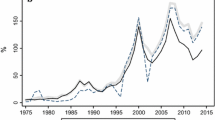Abstract
Using a large sample of firms listed on the Korea Stock Exchange, this paper evaluates the usefulness of a structured, programmable financial statement analysis for investment decisions. In doing so, we develop a firm valuation model which links a firm's market value with fundamental variables such as the ability of a firm to generate cash flows, growth potentials, and risk. We predict a firm's intrinsic value directly from an extensive set of financial statement variables which proxy for the theoretical variables implied by the model. We then construct a series of trading strategies with zero net investment (called D-strategies) on the basis of D-values which measure percentage differences between predicted intrinsic values and observed market values. We observe that the market-adjusted and size-adjusted (hedge-portfolio) returns to the most conservative D-strategy turn out to be in the order of 16.92% and 11.44%, respectively,for the 12-month holding period. When our sample is stratified into two sub-samples based on firm size, the D-strategy yields higher excess return for the small-firm sub-sample than for the large-firm sub-sample. The above evidence, taken as a whole, strongly indicates that one can construct a profitable trading strategy by directly predicting intrinsic values through a structured financial statement analysis such as ours.
Similar content being viewed by others
References
Bae, K. H. and Kim, J.-B. (1998) The usefulness of earnings vs. book value for predicting stock returns and cross corporate ownership, Japan and the World Economy 10, 467-485.
Ball, R. and Brown, P. (1968) An empirical evaluation of accounting income numbers, J. Account. Res. 7, 159-178.
Bernard, V. L. (1992) Stock price reactions to earnings announcements: A summary of recent anomalous evidence and possible explanations. In R. Thaler (ed.), Advances in Behavioral Finance, Russell Sage Foundation, New York, NY.
Bernard, V. L. (1994) Accounting-Based Valuation Methods, Determinants of Market-to-Book Ratios, and Implications for Financial Statement Analysis, Working Paper, University of Michigan, Ann Arbor, MI.
Bernard, V. L., Thomas, J., and Wahlen, J. (1997) Accounting-based stock price anomalies: Separating market inefficiencies from research design flaws, Contemporary Account. Res. 14(2), 89-135.
Blume, M. E. and Stambaugh, R. F. (1983) Biases in computed returns: An application to the size effect, J. Financ. Econom. 23, 387-404.
Calegari, M. and Fargher, N. L. (1997) Evidence that prices do not fully reflect the implications of current earnings for future earnings: An experimental market approach, Contemporary Account. Res. 14, 397-433.
Cheung, J. K., Chung, R., and Kim (1997) The profitability of trading strategies based on book value and earnings in Hong Kong: Market inefficiency vs. risk premia, J. Int. Financ. Managt Account. 8(3), 204-233.
Cook, K. (1998) A foreign buyer's look at M& A in Korea, The Amcham J. (The American Chamber of Commerce in Korea), November-December, pp. 31-32.
Chung, H. Y. and Kim, J.-B. (1994) Financial statement analysis and the profitability of risk-based investment strategy, Advance in International Accounting 6, 117-132.
Chung, H. Y. and Kim, J.-B., and Lee, B. (1999) Market efficiency anomalies in Korea: Mispricing vs. omitted risk factors, Asia-Pacific Financial Markets 6, 311-340.
Edwards, E. and Bell, P. (1961) The Theory and Measurement of Business Income, University of California Press, Berkeley, California.
Demsetz, H. (1973) Industry structure, market rivalry, and public policy, J. Law Econom. 16, 1-9.
Fama, E. F. (1991) Efficient capital markets: II, J. Finance 46, 1575-1617.
Fairfield, P. M. and Harris, T. S. (1993) Price-earning and price-to-book anomalies: Test of intrinsic value explanation, Contemporary Account. Res. 9, 590-611.
Feltham, G. A. and Ohlson, J. A. (1995) Valuation and clean surplus accounting for operating and financial activities, Contemporary Account. Res. 11(2), 689-731.
Frankel, R. M. and Lee, C. C. (1996) Accounting Valuation, Market Expectation, and the Book-to-Market Effect, Working Paper, University of Michigan, Ann Arbor, Michigan.
Holthausen, R. W. and Larcker, D. F. (1992) The prediction of stock return using financial statement information, J. Account. Econom. 15, 373-411.
Jaffe, J., Keim, D. B., and Westerfield, R. (1989) Earnings yields, market values, and stock returns, J. Finance 44, 135-148.
Kim, J.-B., Kinsky, I., and Lee, J. (1995a) The aftermarket performance of initial public offerings in Korea, Pacific-Basin Finance J. 3, 429-448.
Kim, J.-B., Kinsky, I., and Lee, J. (1995b) The role of financial variables in the pricing of Korean initial public offerings, Pacific-Basin Finance J. 3, 449-464.
Lev, B. (1989) On the usefulness of earnings and earnings research: Lessons and directions from two decades of empirical research, J. Account. Res. 27 (Supplement), 153-192.
Lindenberg, E. and Ross, S. (1982) Tobin's q ratio and industrial organization, J. Business 54, 1-32.
Morris, H. (1998) M& A in Korea: Getting it right, The Amcham J. (The American Chamber of Commerce in Korea), November-December, 26-27.
Ohlson, J. A. (1995) Earnings, book values, and dividends in equity valuation, Contemp. Account. Res. 11(2), 661-687.
Ou, J. A. and Penman, S. H. (1989) Financial statement analysis and the prediction of stock returns, J. Account. Econom. 13, 295-329.
Ou, J. A. and Penman, S. H. (1995) Financial Statement Analysis and the Evaluation of Market-to-Book Ratio, Working Paper, University of California at Berkeley, Berkeley, CA.
Roll, R. (1983) On computing mean returns and the small firm premium, J. Financ. Econom. 23, 371-386.
Shleifer, A., and Vishny, R. W. (1992) The impact of institutional trading on stock prices, J. Financ. Econom. 32, 23-43.
Sloan, R. (1996) Do stock prices fully reflect information in accruals and cash flows about future earnings? Account. Rev. 71, 289-315.
Smirlock, M., Gillogan, T., and Marshall, W. (1984) Tobin's q and the structure-performance relationship, Amer. Econom. Rev. 74, 1050-1060.
Author information
Authors and Affiliations
Rights and permissions
About this article
Cite this article
Chung, H.Y., Kim, JB. A Structured Financial Statement Analysis and the Direct Prediction of Stock Prices in Korea. Asia-Pacific Financial Markets 8, 87–117 (2001). https://doi.org/10.1023/A:1011951102564
Issue Date:
DOI: https://doi.org/10.1023/A:1011951102564



